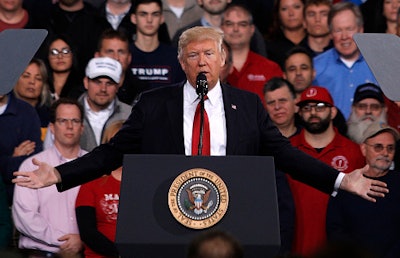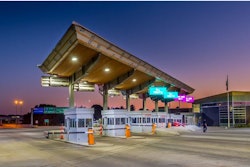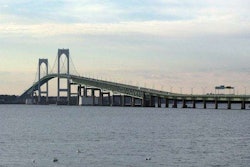
President Donald Trump’s “blueprint” budget proposal is requesting $16.2 billion for the U.S. Department of Transportation’s discretionary budget, which is a 13-percent cut from the 2017 annualized figures.
“The Budget request reflects a streamlined DOT that is focused on performing vital Federal safety oversight functions and investing in nationally and regionally significant transportation infrastructure projects,” the proposal reads. “The Budget reduces or eliminates programs that are either inefficient, duplicative of other Federal efforts, or that involve activities that are better delivered by States, localities, or the private sector.”
The proposal also recommends eliminating funding for the Transportation Investment Generating Economic Recovery (TIGER) Program grants, which generally has distributed $500 million per year to surface transportation capital projects that “generate economic development and improve access to reliable, safe and affordable transportation for communities, both urban and rural.”
Since 2009, the program has provided approximately $4.6 billion to 381 projects in all 50 states, Washington, D.C., Puerto Rico and tribal communities.
The budget blueprint explaining this cut reads:
Eliminates funding for the unauthorized TIGER discretionary grant program, which awards grants to projects that are generally eligible for funding under existing surface transportation formula programs, saving $499 million from the 2017 annualized CR level. Further, (US)DOT’s Nationally Significant Freight and Highway Projects grant program, authorized by the FAST Act of 2015, supports larger highway and multimodal freight projects with demonstrable national or regional benefits. This grant program is authorized at an annual average of $900 million through 2020.
Other items in the USDOT budget proposal include:
♦ Initiates a multi-year reauthorization proposal to shift the air traffic control function of the Federal Aviation Administration to an independent, non-governmental organization, making the system more efficient and innovative while maintaining safety. This would benefit the flying public and taxpayers overall.
♦ Restructures and reduces Federal subsidies to Amtrak to focus resources on the parts of the passenger rail system that provide meaningful transportation options within regions. The Budget terminates Federal support for Amtrak’s long distance train services, which have long been inefficient and incur the vast majority of Amtrak’s operating losses. This would allow Amtrak to focus on better managing its State-supported and Northeast Corridor train services.
♦ Limits funding for the Federal Transit Administration’s Capital Investment Program (New Starts) to projects with existing full funding grant agreements only. Future investments in new transit projects would be funded by the localities that use and benefit from these localized projects.
♦ Eliminates funding for the Essential Air Service (EAS) program, which was originally conceived of as a temporary program nearly 40 years ago to provide subsidized commercial air service to rural airports. EAS flights are not full and have high subsidy costs per passenger. Several EAS-eligible communities are relatively close to major airports, and communities that have EAS could be served by other existing modes of transportation. This proposal would result in a discretionary savings of $175 million from the 2017 annualized CR level.
The full budget proposal document is available here.












